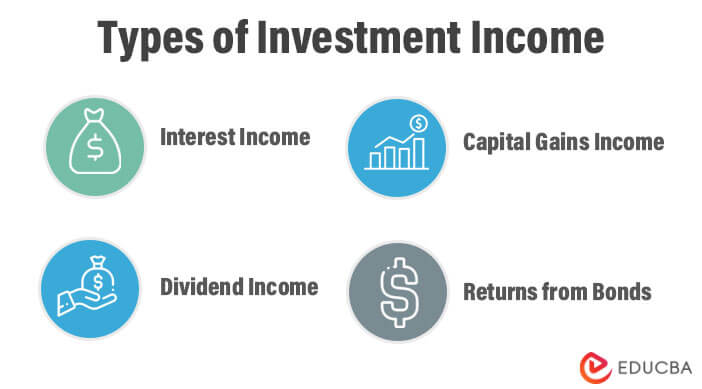Updated July 17, 2023
Introduction to Investment Income
Investment Income (may or not be a part of “other incomes” in the financial statements) is the source of revenue generated through investment in various financial instruments such as stocks, debentures, land, saving plans, etc., earning revenues such as dividends, interest, bonus, capital gain, revenue gain or any other gain and such gains are normally treated as a secondary source of revenue.
Explanation
- As the name suggests, investment income is income generated through investments.
- The primary source of revenue for a corporation whose business is to produce revenues through significant investments is income, which is recorded in “revenue from operations” in the financial statements. Such income typically comes from secondary sources of income in regular circumstances.
- A secondary source of revenue means the focus is not on generating this income. Such income is automatically generated without placing much effort.
- The primary objective of investment income is to beat the time value of money along with general inflation prevailing in the market. Say you invested $ 100,000 with shares. The dividend income you receive will also compensate for the time value. Suppose you deposited the same amount in a fixed deposit with any commercial bank; the interest earned in such case beats both time value and inflation.
How to Calculate Investment Income?
- Step 1: The first step is to collate the information related to all your investments. Such information can easily be traced through hard papers, emails, or messages. The information such as rate of interest, date of payment, amount of investment, date of investment & maturity, etc., is mentioned in such sources of information. All you need to do is to structure the information in an appropriate manner.
- Step 2: The next step is to process the available information through an Excel sheet. Specify the formulas for the calculation of investment income to date.
- Step 3: Using step 2, calculate the income amount. The next step is to calculate the rate of return earned. The rate of return is the average return for all investments, holding period return for certain investments or capital gain returns, etc.
- Step 4: You can decide whether to withdraw or reinvest the return amount. If the amount of return is not that significant, it is always suggested to reinvest the income into the same or another financial instrument.
Example of Investment Income
An investor is cash rich & has invested in many financial instruments. He has provided the following information about his investments. He is curious to know the return he earns as of date for each investment & the overall return of the entire investment.
|
Particulars |
Quantity | Rate ($) |
Amount of Investment ($) |
| Stock A | 7,500 | 65 | 4,87,500 |
| Time deposits with Bank | 1,50,000 | ||
| Land | 1,25,00,000 | ||
| Fixed Income Bonds A | 50,000 | 95 | 47,50,000 |
| Stock B | 10,500 | 500 | 52,50,000 |
| Stock C | 8,500 | 16 | 1,36,000 |
| Fixed Income Bonds B | 28,400 | 75 | 21,30,000 |
| Stock D | 2,015 | 60 | 1,20,900 |
| Mutual Fund A | 19,500 | 165 | 32,17,500 |
| Mutual Fund B | 19,500 | 205 | 39,97,500 |
| Stock E | 1,560 | 650 | 10,14,000 |
| Total | 3,37,53,400 |
Solutions:
Average Return
| Particulars | Category | Amount of Investment ($) (A) | Quantity (B) | Market Rate as on date($) (‘C) | Market Value ($) (D = B*C) | Return ($) (E = D-A) | Return (%) E/A*100 |
| Stock A | Equity | 4,87,500 | 7,500 | 74 | 5,55,000 | 67,500 | 14% |
| Time deposits with Bank | Cash Equivalents | 1,50,000 | – | – | 1,62,000 | 12,000 | 8% |
| Land | Real Estates | 1,25,00,000 | – | – | 1,65,00,000 | 40,00,000 | 32% |
| Fixed Income Bonds A | Fixed Income | 47,50,000 | 50,000 | 100 | 50,00,000 | 2,50,000 | 5% |
| Stock B | Equity | 52,50,000 | 10,500 | 400 | 42,00,000 | -10,50,000 | -20% |
| Stock C | Equity | 1,36,000 | 8,500 | 20 | 1,70,000 | 34,000 | 25% |
| Fixed Income Bonds B | Fixed Income | 21,30,000 | 28,400 | 83 | 23,43,000 | 2,13,000 | 10% |
| Stock D | Equity | 1,20,900 | 2,015 | 68 | 1,37,020 | 16,120 | 13% |
| Mutual Fund A | Mutual Funds | 32,17,500 | 19,500 | 168 | 32,76,000 | 58,500 | 2% |
| Mutual Fund B | Mutual Funds | 39,97,500 | 19,500 | 210 | 40,95,000 | 97,500 | 2% |
| Stock E | Equity | 10,14,000 | 1,560 | 580 | 9,04,800 | -1,09,200 | -11% |
| Total | 3,37,53,400 | 3,73,42,820 | 35,89,420 |
The average return here is $ 3589420 / 33753400 = 10.63%
Explanation
- The investor has earned good returns in stocks. The market rates are considered for computing the unrealized gain of the investor.
- The investor has earned lower but sufficient returns in bonds and mutual funds.
- The unrealized value of land is considered only for valuation & the investor will not choose to sell instantly.
Types of Investment Income
Following are the types of investment income are:
- Interest Income: This is the basic income generated when you place your money in some bonds, certificate of deposit, or any other financial instrument bearing interest. Investors can either withdraw the realized gain or can reinvest the amount back into the same source of investment. The interest income is normally periodic & consistent. The investor further has to pay tax on such interest income. In exceptional cases, the government allows an exemption for interest income.
- Dividend Income: You hold a share of a company whenever to invest in stocks. The company earns profits after tax for its shareholders. The company has the option either to distribute a small part of such earnings or to retain that part as well. Well, it depends on the projections of the company. If a company has future plans of expansion & it can earn more than the normal return through such expansion, it will not distribute the said amount as a dividend.
- On the other hand, it may distribute the same to shareholders. Such income is normally consistent in nature. Dividends are normally paid annually.
- Capital Gains Income: Dividend income is when the company distributes its part of earnings. Capital gain is when you sell the holding shares in the market. The difference between the buy price & sell price is called a capital gain. It can be manifold. The quantum of capital gain depends on the period of hold & the attributes of the stock. Quality stocks rise manifold in 2-3 years. However, the investor is required to pay taxes such as capital gain. If the stocks are sold within 12 months from the date of purchase, it is a short-term capital gain; otherwise, it is a long-term capital gain. Short-term capital gain attracts a higher rate of tax than long-term capital gain.
- Returns from Bonds: When you purchase a bond, you have lent your money to the seller or issuer of the bond for a certain period of time. The easiest way of earning money is to hold the bond till its maturity & to enjoy capital gain as well as in-between cash flows from the bond. However, you may choose to sell the stock in the middle of the maturity period observing the higher selling price.
Advantages
- It is a secondary source of revenue or, one can say, “passive income”.
- Such income does not need separate attention & it grows with time.
- It helps create wealth even if you focus on the active source of earning.
- When you have huge cash flows, investing is always suggested rather than holding the cash flows.
- Such income becomes the backbone at the time of retirement benefits. A person will not have rich cashflows at the last stages of life. Thus, investment income from bonds, FDs, mutual funds, stocks, etc., will help him to earn at least survival revenue to manage his expenses.
- A person becomes financially independent when there are lots of investments made.
- Properly managing investment income will help a person channel the expenses through investment income.
Disadvantages
- The income from stocks is volatile in nature. It may or may not provide you with a specific amount of return in case of the downside of the entire market.
- The management of the portfolio is necessary if one wants to play safe. If 100% of the investment is made only in stock, your portfolio depicts the exact return & risk as per the very dangerous market. It may even wipe out the investments.
- Incomplete knowledge is always dangerous. The person needs to have knowledge of investment in various streams.
- Investment income is not tax-free. The person has to pay taxes such as income. In fewer cases, there are exceptions.
Conclusion
Some extra is always better. So, when you are cash-rich, you should invest in stocks, bonds, time deposits, etc., to keep the money blocked in some instruments that generate revenue. A running inflow of money is always attractive & satisfying at the same time.
Recommended Articles
This is a guide to Investment Income. Here we discuss the introduction, how to calculate investment income step by step, and advantages and disadvantages. You may also have a look at the following articles to learn more –





